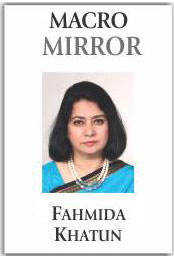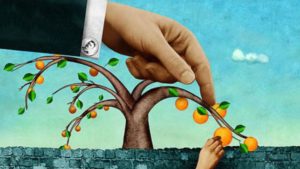Published in The Daily Star on Monday, 24 October 2016
MACRO MIRROR
Growth is real only if it is inclusive – Dr Fahmida Khatun
 Bangladesh had an exceptional six days this month. Starting with the visit of the Chinese President Xi Jinping and ending with that of the World Bank president Jim Yong Kim, the country went through a period of euphoria.
Bangladesh had an exceptional six days this month. Starting with the visit of the Chinese President Xi Jinping and ending with that of the World Bank president Jim Yong Kim, the country went through a period of euphoria.
During those days, ministers, politicians, experts, business leaders, media personalities and development partners from South Asia and beyond gathered to discuss the region’s economic prospects at the Ninth South Asia Economic Summit organised by the Centre for Policy Dialogue. Everywhere Bangladesh’s achievements got prominence. Based on what Bangladesh has done so far and what more potential the country can have, visiting leaders have committed to support the country in various forms. The Chinese President offered a package of investment and trade worth nearly USD 40 billion. Soon after his departure comes the World Bank President with a bag full of praises and promises for Bangladesh. For its spectacular success in reducing poverty, Bangladesh was chosen to observe this year’s End Poverty Day. Kim also committed to increase financial support for improvement of child nutrition by USD 1 billion in the next three years and to invest another USD 2 billion on climate change projects for the same length of period.
Suffice to say, there could not be a better choice than to pick Bangladesh to celebrate the day. The country has been able to reduce its extreme poverty rate to 12.9 percent in fiscal year 2016 from 18.5 percent in 2010 and from 44.2 percent in 1992. These are the people who live on USD 1.9 per day at 2011 purchasing power parity, according to the World Bank. The reduction has been possible due to the country’s growth spurt by 1 percentage point every decade. With 7.1 percent growth of its gross domestic product in 2016 the country is now among the fastest growing nations in the world. Coupled with economic growth has been its progress in human development indicators over the past decades.
In one sense, the Chinese and the World Bank money complement each other from Bangladesh’s vantage point. While the Chinese have targeted physical infrastructure, the World Bank has chosen soft infrastructure, both crucial for the country’s development. Infrastructure deficiency is blamed for poor investment-GDP ratio in Bangladesh which is still below 30 percent. Indicators such as Global Competitiveness Index, Doing Business and Global Corruption Perception Index reveal structural weaknesses of the economy. As opposed to the feel good factors about the progress of the country, one cannot also ignore the distributional aspect of such development. Income inequality is high with the top 5 percent of the population enjoying 24.6 percent of total national income and the bottom 5 percent only 0.78 percent, according to Bangladesh Bureau of Statistics.

High income inequality can perpetuate inequality in other areas, in case of social and political opportunities, for example. While access to education and health has increased by a large number of people, the quality of these services vary significantly across economic strata. The quality of education received by the poor is not the same as that of the rich children. Hence youths face unequal competition in the job market. The number of stunted children is very high; they are children from deprived families who cannot afford nutritious food and medical bills when their children get sick. One would not see these children in the class room or in the cricket field. Unequal access to opportunities in turn leads to income inequality. It creates inter-generational poverty. The poverty cycle goes on if the government cannot create equal opportunities for everyone.
Those who have crossed the extreme poverty threshold are vulnerable to shocks – economic, social, environmental and political. There are poverty pockets in Bangladesh such as coastal areas, Chittagong Hill Tracts, Char and Haor areas where the concentration of the extreme poor is higher than other areas. Social safety net programmes for these people and other extreme poor will have to be expanded both in terms of number and amount. At the same time poor working population have to be brought into the employment market. The challenge of providing employment to the two million new entrants into the labour market every year is not an easy task. The structural change of the economy from a predominantly agricultural to an industry and services based one, has not brought adequate jobs and higher income for all. The dual challenge of creating better jobs ought to be addressed through transformation in the whole knowledge ecosystem. Technology and innovation can create opportunity. Education and skills development can provide access to opportunity.
Poverty is an absolute concept and is defined mostly in income terms even though economists have attempted to develop multi-dimensional indices of poverty. Inequality, which is measured in relative terms indicates the need for distributive justice. This has to be ensured through strong institution and good governance. How the efficiency of both external support and domestic resources will be utilised will depend on the effectiveness of institutions. How higher growth will benefit people across the board will depend on how just the governance system is. After all, benefits of Chinese infrastructure development and World Bank’s child nutrition improvement and climate change projects have to reach the poor by way of creating more jobs, higher income and reduced vulnerability. As Bangladesh is upbeat on taking the growth to a new height to reach a middle income country by 2021, it should not lose sight of making growth equitable and inclusive by creating opportunities for all.



